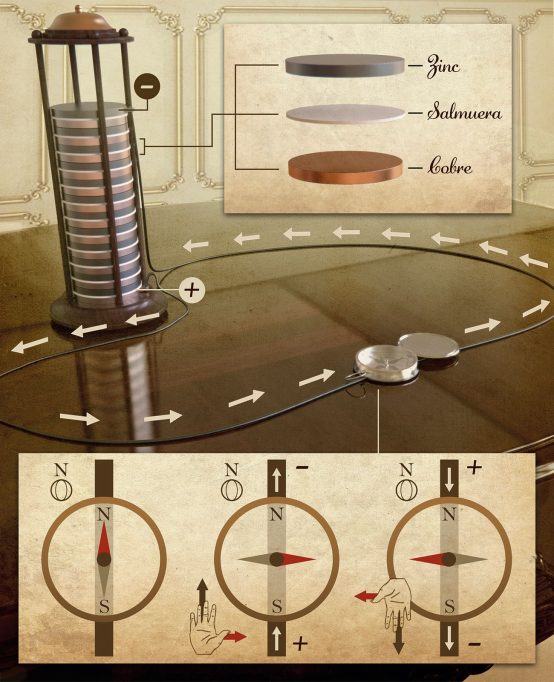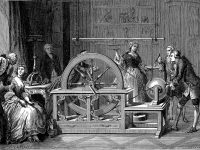
Illustration: Hugo Salais
My friend Rafa (who was already sticking his fingers into sockets at the age of two, when the voltage was 120 volts) challenged me to lick the terminals of a battery when we were eight years old. Having plucked up the courage, I put my tongue close to it and felt an annoying tingling sensation with an indefinable taste. I did not repeat the experience. Much later, I discovered that it all began with a (famous) controversy between Luigi Galvani, who experimented with frogs’ legs, which he claimed contracted due to an intrinsic electricity in the animal, and Alessandro Volta, for whom the frog was merely a conductor of the electricity produced by the metal connectors attached to it. Volta felt the effects by placing a (connected) silver spoon and a piece of tin foil on his own tongue (instead of the frog’s). After several tests, he piled up pairs of zinc and copper discs, alternating them with others soaked in brine or even an acid (who has never made a Voltaic pile with a lemon?) and verified that an electric current was produced, similar to that produced by a rubbed object when it is discharged. He presented his invention to the Royal Society in 1800 and, having become a celebrity, gave lectures in Paris which were attended with great interest by the First Consul, Napoleon Bonaparte. Years later, when Napoleon had made himself Emperor, he ordered – partly, it is said, because of a dispute with the English – 600 batteries that filled a large room at the École Polytechnique. Now taken for granted, used to power clocks, radios, mobile phones and cars, the batteries were at the time a state-of-the-art device that produced a constant current for the first time. Although there was no explanation for the phenomenon at the time, its spread through academies and universities was unstoppable, leading to an explosion of experiments in physics and chemistry. It also gave rise to alleged therapies or macabre spectacles, such as those of Giovanni Aldini, which may have inspired Mary W. Shelley when she wrote her Frankenstein.
Hans Christian Oersted’s experiences at the University of Copenhagen have left a special mark on our scientific and social history. In 1820 he discovered something unusual: the needle of a compass pointing north, parallel to a nearby wire, rotated to point west when current flowed through the wire. When the current flowed in the opposite direction, the needle pointed east, and it returned to its original position when the current stopped. If the compass moves, it must be because the electric current produces a magnetic effect. On learning of these results, French scientists such as Biot, Savart, Aragó, and Ampère embarked on a frenzy of experimental and theoretical activity, systematising the new electromagnetism, and naming the theorems that we now study in textbooks. Ampère immediately proposed that all magnetic phenomena were in fact due to electric currents. This was true even for magnets or materials such as iron (i.e., currents exist at the atomic level).
Until then, although there had been reports of compasses on ships being reversed when struck by lightning (and even of some knives in a chest being magnetised after an impact), electrical and magnetic phenomena were thought to be unrelated. Oersted, inspired by Schelling’s Naturphilosophie with ideas from Spinoza and convinced of the unity of the forces of nature, sought a connection. A good example of the role of other currents in science, those of cultural and philosophical ideas: he explored a connection that the best French scientists had not considered, even though voltaic batteries had been available for twenty years. This is just one example of how the quest to understand nature has in the past led to a wealth of scientific knowledge as well as immediate, unforeseen applications. Telegraphs, electric motors, and electromagnets (the latest versions of which are fundamental to spectrometers, particle accelerators, and synchrotrons) were soon to follow.
As for my friend Rafa, who from childhood was interested in experimenting with batteries and sockets, he preferred the latter: he studied engineering and for years directed the construction of power stations. They produce another type of current, alternating current, which we will talk about soon.
Try it:
You will need a compass, a battery (9V is best) and about 1 metre of electric cable (strip the ends and wrap them around two metal clips which you will later connect to the battery).
- Lay the unplugged cable on the table and place the compass on top as shown. The needle should be pointing towards true north (N) and the wire should be aligned with the compass needle. Connect the North end of the cable to the negative (–) connector on the battery. Briefly touch the other end of the wire to the positive (+) connector (if left in, the battery will discharge quickly). The compass needle will point to the east and return to its original position when the cable is disconnected and the circuit is open.
- Now switch the battery poles (– is + and vice versa). See what changes.
- Repeat a) or b), but now with the wire above the compass instead of below it. Is there any difference?

